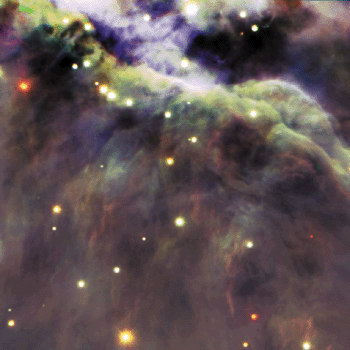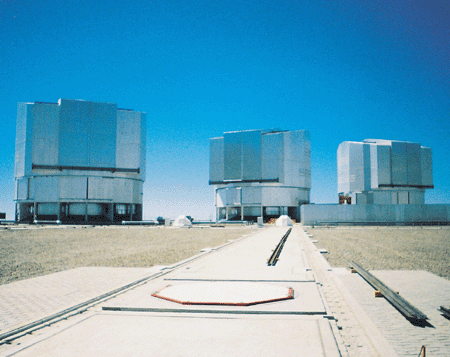Early results from two new observatories - Gemini South and the Very Large Telescope - mark the beginning of a new era in astronomy, as Valerie Jamieson reports from Chile.

The latest telescope that is capable of studying the Southern sky in detail was unveiled in January amid a fanfare of Andean pan-pipe music and choreographed movements of its 8.1 metre mirror. The Gemini South telescope at Cerro Pachón in Chile is set to provide astronomers with the sharpest ever infrared images of both distant galaxies and the star-forming regions in our Milky Way galaxy.
Together with its twin, Gemini North at Mauna Kea in Hawaii, the two telescopes can observe the entire sky and thus respond to rare and unpredictable events, such as outbursts from black-hole binary systems, that occur anywhere in the heavens. And 700 kilometres away, the four 8.2 metre mirrors of the Very Large Telescope have started looking at individual stars in unprecedented detail.
Astronomers from the US, the UK, Canada, Chile, Australia, Argentina and Brazil are already queuing up to use Gemini South and observing time is five times oversubscribed. “The proposals cover the gamut of observational astronomy, including solar-system objects, nearby star-forming regions, cool stars, brown dwarfs and massive extrasolar planets,” says Phil Puxley, assistant director of the Gemini Observatory. Nearby galaxies, clusters of galaxies, gamma-ray bursts and quasars are also on the list of must-have observations.
High sensitivity and high resolution
Both the Gemini telescopes have been optimized for infrared astronomy to a greater extent than the two 10 metre Keck telescopes in Hawaii. Patrick Roche, a project scientist at Oxford University in the UK, explains that the Earth’s atmosphere has two natural windows through which the faint infrared glow from stars and galaxies can pass. Heat from the observatory structure must not swamp these windows to ensure that the telescope has high sensitivity at infrared wavelengths. For example, the dome of the telescope is ventilated to prevent heat from being trapped inside the telescope and the secondary mirror is supported on thin steel-alloy struts to minimize thermal emission.
The sensitivity of the telescope will be improved even further early next year when the aluminium layer that currently coats the primary mirror will be stripped off and replaced with a thin layer of silver, which is more reflective in the infrared.
Previous ground-based telescopes have achieved resolutions of 0.5 arcseconds, but only occasionally during dedicated observations. Meanwhile, the near-infrared camera on the Hubble Space Telescope has captured images with a resolution of 0.2-0.3 arcseconds over a small field of view. In contrast, Gemini North has already been able to image certain parts of the galactic centre in the near-infrared with an angular resolution of 0.1 arcseconds thanks to some clever optical trickery.
Each Gemini telescope has a primary mirror measuring 8.1 metres in diameter made of fused blocks of ultralow-expansion glass. Since the mirror is just 0.2 m thick, it deforms due to gravity as it is manoeuvred into position. A series of sensors and actuators detect this distortion and nudge the mirror back into its perfect shape. Meanwhile, the focus and angle of the secondary mirror can be adjusted up to 100 times per second to correct for wind-induced vibrations and some gross distortions in the atmosphere.
Finer corrections for atmospheric turbulence can be made by directing the light through an “adaptive optics” system of smaller mirrors after it has been reflected by the secondary mirror.
The current system at Gemini North measures the distortions of a bright star near the object that the astronomers want to study. Knowing that this star is a point, the adaptive-optics system can work out how the wavefront of the light is distorted by turbulence in the atmosphere and adjust the smaller mirror to correct for the effect.
Astronomers have more ambitious plans for Gemini South, which currently has an angular resolution of 0.5 arcseconds without adaptive optics. They aim to cancel out the turbulence over an area of sky some 20 times larger than that of its twin using a constellation of “artificial stars”. These stars will be created by shining lasers into the atmosphere to excite the sodium layer. Matt Mountain, director of the Gemini Observatory, expects the resolution at the Southern telescope to improve to 0.07 arcsecond by 2005.
Early results
Phil Lucas of the University of Hertfordshire and Roche of Oxford University in the UK are among the lucky ones who have already made observations with Gemini South during the commissioning phase. They recently obtained images of a star-forming region within the Orion nebula called the central Trapezium at three different wavelengths using a near-infrared spectrograph (see figure).
Since infrared radiation can penetrate through all but the densest clouds of dust, the UK team were able to see for the first time faint red objects weighing just a few times the mass of Jupiter. These objects may be extrasolar planets that have formed within a stellar nursery containing stars just one million years old. “Exactly how these objects formed is not understood,” says Roche. “We don’t know if they condensed from a molecular cloud that fragmented or if they formed from even smaller objects.” The team plans to follow up these measurements using the high-resolution spectrometer on Gemini North. Fortunately the Orion nebula is located in a region of sky that is covered by both telescopes.
With a primary mirror that measures 8.1 metres across, Gemini has ten times the light-collecting power of the Hubble Space Telescope. As a result, Gemini will be able to analyse the light from old and distant galaxies that has been redshifted on its journey to the Earth, as well as light from faint galaxies containing cool stars.
Moreover, mid-infrared observations that were made last year with Gemini North by Eric Perlman of the University of Maryland’s Joint Center for Astrophysics are prompting theorists to re-think their ideas about the cores of “active galaxies”. Previously astronomers had thought that a tiny torus-shaped region of hot dust emitted intense infrared radiation as it was sucked into a black hole at the centre of the active galaxy. But the high-resolution infrared images of galaxy M87, some 50 million light-years away, revealed no such region.
From the Southern hemisphere astronomers can see the Magellanic Clouds – our nearest neighbouring galaxies – and the bulge at the centre of the Milky Way, which is thought to harbour a supermassive black hole. Roger Davies of Durham University in the UK says that Gemini’s high sensitivity and excellent angular resolution will be crucial for black-hole research. “To determine the mass of a black hole at the centre of a galaxy involves measuring the kinematics of the orbiting stars or gas, which in turn relies on the linear resolution,” he explains. “Clearly, if we can improve the resolution from 1 arcsecond to 0.2 arcseconds, we can derive a mass limit on the black hole that is five times better.”
Interferometric success
Far north at Cerro Paranal in the Atacama desert, it is easy to see why Chile ranks as one of the best location in the world for astronomy. Over 100 kilometres from the nearest town, the sky is perfectly clear and the air is so dry that even the toughest male astronomers wear moisturizing lotion. All four of the 8.2 metre telescopes that make up the Very Large Telescope (VLT) at Cerro Paranal began operations last year. Images of the Eagle and Horsehead nebulae, Saturn and the Jovian moon Io, and the first observation of a massive compact object or MACHO are among the latest highlights. But Massimo Tarenghi, head of the telescope division at the European Southern Observatory headquarters at Garching in Germany, can barely conceal his delight at the recent success of the VLT’s interferometer.
By combining the light from several telescopes in phase using an interferometer, astronomers at the VLT are aiming to improve the angular resolution to a few milliarcseconds – equivalent to the resolution of a telescope with a diameter of 200 metres. From the resulting interference fringes, astronomers can work out the size of a star and deduce its shape. Moreover, they hope to be able to resolve stellar structure and any orbiting planets. And on extragalactic scales, they even expect to study individual stars around black holes.
Late last year, Tarenghi and his team observed the star Alpha Eridani with two of the four 8.2 metre telescopes and directed the light into the underground interferometer where it was combined in phase. Analysis of the contrast between the fringes revealed the angular diameter of the star to be 1.9 ± 0.05 milliarcseconds. But Tarenghi is most thrilled about the observations of pulsating stars known as Cepheid variables. Because these stars brighten and dim with a period that is correlated to their luminosity, Cepheids provide reliable distance measurements. Indeed, in 1923 Edwin Hubble used these stars to show that the universe is expanding.
“Previous measurements of the diameter of Cepheids had huge errors, but our data are rather good,” smiles Tarenghi. Indeed, the accuracy of the diameters of Zeta Geminorum and Beta Doradus, a star that has never been measured before, are better than 2%. Next year Tarenghi’s team plans to combine the signals from three telescopes for the first time to produce images from the interferometer in addition to the fringes.
Astronomers often talk of a “golden age” of astronomy. The Gemini telescopes and the VLT will ensure that this golden age will continue for many years to come.




